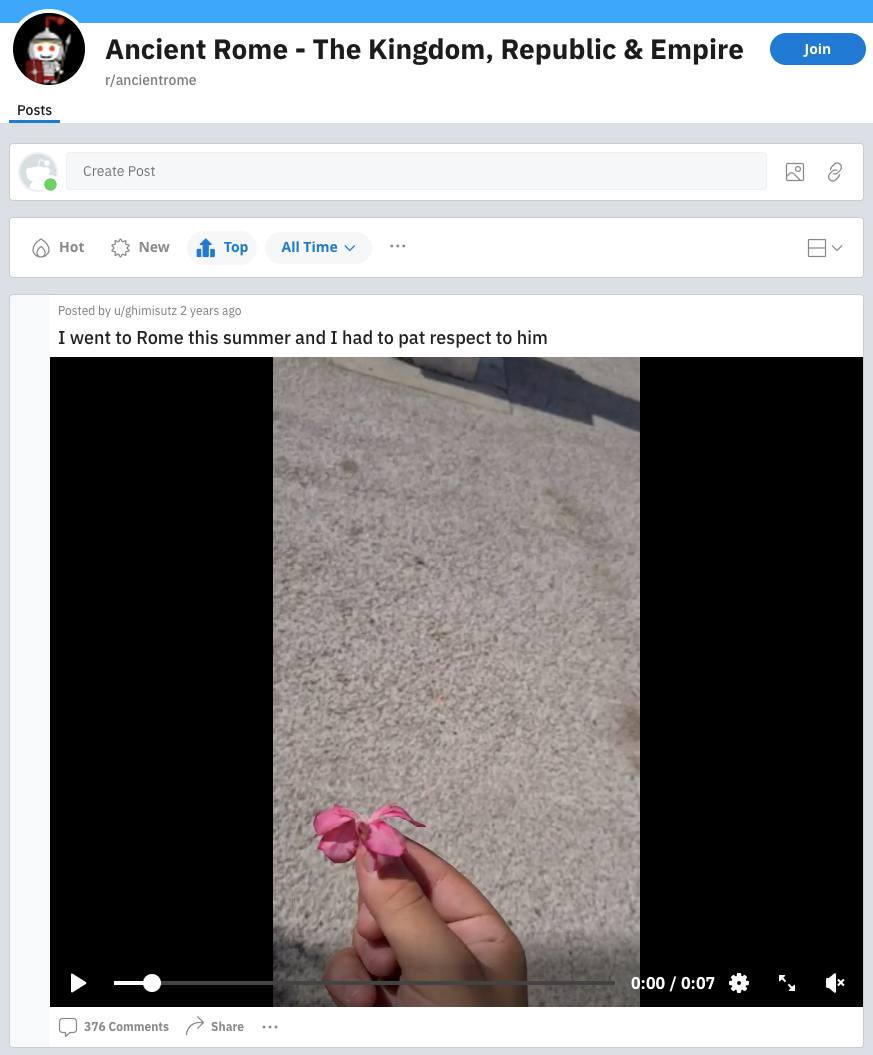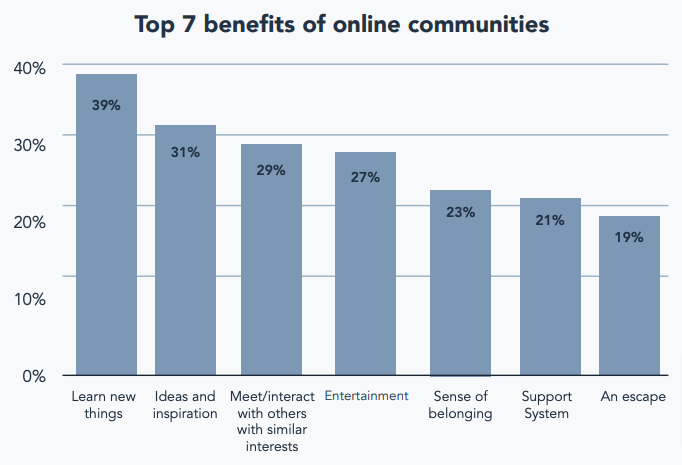Ecommerce brands could learn a lot from Taylor Swift.
Over the years, Tay Tay has built a community of devout #Swifties desperate for every last scrap of information about their icon. Because they love Taylor, they give up their time to promote her music, share her content, and help her win every award under the sun…
Vote for Taylor so she wins at the ARIAS by tweeting and replying with #ARIAsTaylorSwift! pic.twitter.com/A4ND0Spezv
— Ari ᱬ⸆⸉ (@Aris_Multiverse) September 22, 2023
Not only that, but their fanaticism helped her notch up (probably) the highest-grossing tour of all time.
All of which demonstrates the overwhelming value of an active, engaged fanbase.
In this article, I’ll discuss the benefits of building your own ecommerce community, including advice on how to do it, examples from real-world retailers, and insights from experts at brands like BattlBox, Outdoor Vitals, and Twee.

What Is an Ecommerce Community?
An ecommerce community is a network of like-minded internet users who come together to share information about their favorite brands and products. They exist in various online locations, including:
- Subreddits
- Forums
- Facebook groups
- Niche websites
Sometimes, ecommerce communities develop and grow independently and organically. But more often, they require a concerted effort from the brand to get them off the ground.
Is it worth it? Let’s consider some of the benefits…
Why Create a Community Around Your Ecommerce Brand?
Creating a community around your ecommerce brand helps you forge a closer relationship with your audience, which in turn encourages them to stick with you through thick and thin. Indeed, 58 percent of brands with online communities say their customers are more loyal to the brand because of their community.
Of course, creating or fostering an ecommerce community is intimidating.
You can’t control the conversation. What if your customers suddenly turn on you, or recommend products from other brands, or descend into Lord of the Flies-style infighting?
That’s all part of the contract—and, in our view, the benefits are worth the risk. As well as increasing customer loyalty, creating an ecommerce community can:
- Help you better understand your audience. Communities are like having an always-on customer feedback survey. When you launch a new product, promote an offer, or share a piece of content, members won’t be shy about whether they like it!
- Reduce your reliance on social media algorithms. Organic social media engagement is falling all the time. By building a community that your audience actively seeks out, you don’t have to trust that your social posts will show up in their social feeds.
- Generate more customer referrals. The more that customers feel connected with your brand, the more likely they are to recommend you to their friends and family. That’s fantastic news, with research finding that referred customers generate higher profit margins, are more loyal, and show a higher customer lifetime value.
- Create value for your audience. An ecommerce community transforms you into more than just another brand selling a product. Instead, you’re offering something truly useful to your audience, giving them a reason to keep coming back.
How to Create a Community Around Your Ecommerce Brand
Like the sound of launching your own ecommerce community? Here’s how to make it happen…
Provide Value
Take a look at your favorite forum or subreddit.
I’ll bet that the most popular posts have something in common: they all offer some sort of value to the reader, whether that’s a specific piece of useful information, or just some entertaining discussion around an interesting topic.
And I’ll bet that few, if any, of those top threads involve selling a product or service.
This brings us to a key point: if your ecommerce community doesn’t offer something valuable to your audience, there’s little incentive for anyone to join. And even if they do join, they won’t come back for more unless you give them a good reason.
Of course, “value” is a pretty broad term. It’ll inevitably mean different things to different audiences.
For Derek Rasmussen of Outdoor Vitals, his brand’s ecommerce community—a closed Facebook group—has flourished as a place where lovers of the great outdoors can seek advice from like-minded folk.
He believes this is the community’s greatest value-add. And it seems consumers agree, with “learning new things” rated as the #1 reason for joining an online community.
“It's a place where there's no trolls and everybody that's in that group is there because they want to be,” Derek explains. “They'll help you solve your problems, they'll help you gain more confidence for backpacking, maybe doing higher miles on a trail than you've ever done before, and that's been awesome.”
But that’s not the only way to create value.
Consumers relish the opportunity to connect with them on a more human level. That’s a big source of value for brands that play an active role in running their ecommerce community.
John Roman of survival gear subscription box brand BattlBox believes this has been a major differentiator for his company and its community. “I make it a point to go in there and interact, and you don't get that from most other brands. You don't have senior leadership in there engaging with the consumers.”
Engage Your Community
Every brand wants to build a more engaged audience.
Launching an ecommerce community is an obvious way to do that, giving you instant access to a group of customers who actively want to hear from—and discuss—your brand.
However, it’s important to remember community members aren’t a homologous group.
Sure, they like you more than the average consumer. But they joined for different reasons, and they’re at various stages of the customer lifecycle. So if you’re going to build an engaging community, you need to craft content and messaging that resonates with members at all stages of their journey with your brand.
This is especially the case for a company like Twee, a woman-owned maker's studio that creates art tools for kids. As CEO Margaux DelCollo explains: “We have the honor of staying with a customer from when they first start to experiment with making art, all the way until they're ready for professional materials.”
Clearly, its community members want very different information and content based on the age of their children. Some are barely out of diapers; others are school-aged.
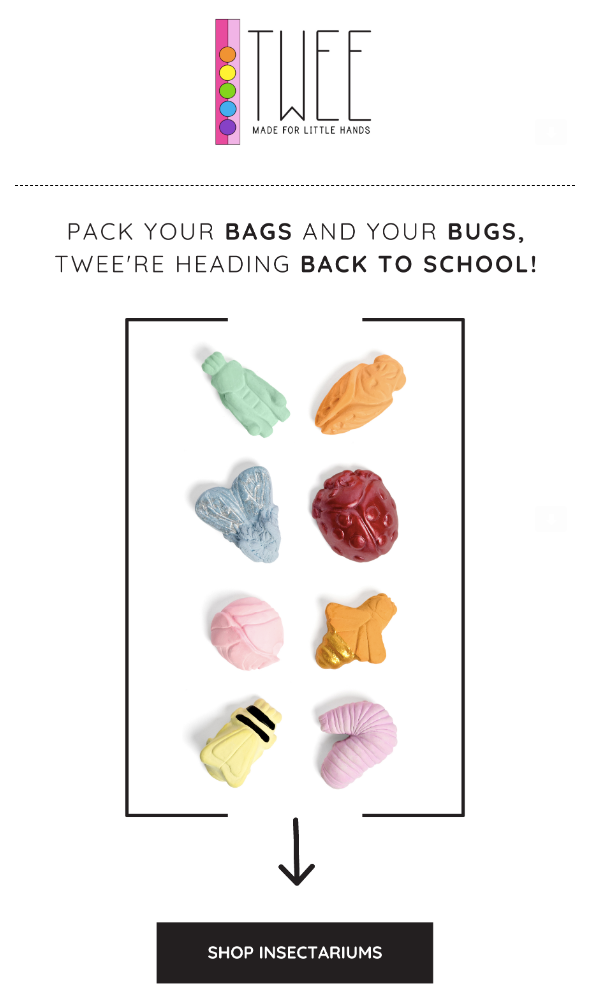 For parents of three-year-olds, their little ones basically just want to smear themselves in paint, glue, and sticky gems. But older kids are looking for something a little more sophisticated.
For parents of three-year-olds, their little ones basically just want to smear themselves in paint, glue, and sticky gems. But older kids are looking for something a little more sophisticated.
As such, Margaux likens their community engagement activity to a multi-year welcome sequence.
“For someone who has joined our email list and has expressed an interest in three-year-old activities, the emails that we can create for them are targeted towards the age group that they're interested in, and then we progress with them.”
But engaging your community isn’t all about the content you create; it’s also about the experience you provide.
Douglas Lim from Crochet Surprise explains how, in the early days of the brand, he and his wife Sarah handled all the customer service themselves.
Sure, it was tiring, and Douglas doesn’t recommend this as a long-term strategy. But he believes it yielded a ton of benefits in terms of bringing their audience closer to the brand.
“We were answering these customer inquiries using our own personality,” he says.
“We also had a Facebook group, and we personally replied to a lot of emails adding our own personality, so we got to know our customers really, really well.”
Incentivize Membership
Traditionally, the vast majority of ecommerce communities have been free to join and participate in.
But things are changing. Today, many brands are looking to incentivize paid memberships—and consumers are waking up to the benefits.
Everyday carry gear brand Urban EDC started out with a free online community run through a Facebook group, but increasingly realized the limitations of this approach.
“It's really good for branding and getting awareness about your brand,” says founder Yong-Soo Chung. “But then the Facebook group really is not meant to be a place for deep discussions and deep relationship-building.”
This realization prompted Urban EDC to launch a two-tier paid community, with the base level priced at $9 per month and the upper tier costing $99 per month. Membership is incentivized through various perks, including:
- Entry to the brand’s Discord server
- Participation in an online buy-sell-trade group
- Access to exclusive products
And Yong-Soo points out another, less obvious, user benefit: “Since it's a paid membership, there's not going to be scammers, because that's pretty rampant in the everyday carry community.”
Outdoor Vitals is another brand that’s added a paid element to its ecommerce community.
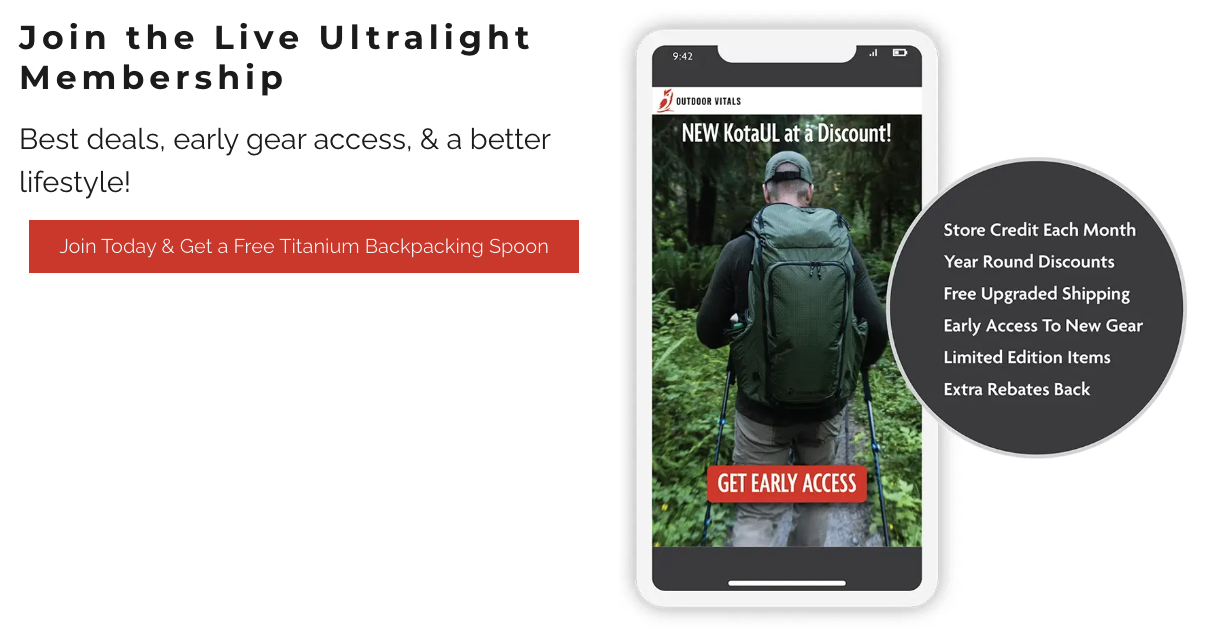 Marketing Director Derek Rasmussen says it’s worked “phenomenally well”, largely thanks to its wealth of membership perks.
Marketing Director Derek Rasmussen says it’s worked “phenomenally well”, largely thanks to its wealth of membership perks.
“It essentially gives members the ability to get better deals year round—discounts, better shipping options, and early access to product launches. They put in a little bit of money each month, which is returned to them immediately as store credit, so it's essentially free.”
Leah McHenry of Mythologie Candles does the same for her store – members of the community get access to exclusive drops, and get to take part in naming new candles. This focus on interactivity is an interesting way to get community members engaged, while rewarding them for that engagement.
Encourage Connection Between Members
Let’s take another look at the top reason why people join online communities:
You could argue most—if not all—of those reasons are at least somewhat related to the relationships between members. So if you’re hoping to expand your community, you should be doing everything in your power to foster that sense of connection.
That’s precisely why dog training gear brand KONOS decided to switch the focus of their ecommerce community away from Instagram.
Founder and CEO Michelle Lai-Saun Chu says Instagram helped her engage the brand’s audience and drive website traffic, but wasn’t the right platform for drumming up ongoing conversations between members.
“I wanted an online space for people where they could connect with other imperfect dog parents, share resources, and support each other when they're going through different challenges,” she explains.
The answer? Discord.
Since switching to the new platform, Michelle says it’s become easier for members to help one another out, rather than relying on her for advice.
“We've got some people whose dogs are struggling with separation anxiety and I don't specifically have a lot of firsthand experience with that, but there are other people in my community that have,” she says.
“That ability for them to connect with each other and share tips on what they did to get through those challenging times is really beautiful to see.”
She says, even though it wasn't necessarily her intention, community building has also been great for customer retention for KONOS.
Ecommerce Community Examples Worth Checking Out
We’ve already heard insights from a bunch of ecommerce leaders who’ve built thriving online communities. Now, let’s explore three
Sensi Graves Swim
For sustainable swimwear brand Sensi Graves Swim, building an ecommerce community hasn’t just been a useful way to drum up some extra engagement and sales—it’s been a crucial part of their whole product lifecycle.
As a small manufacturing brand, cash flow is always an issue. Launching a new product requires them to lay down a bunch of cash upfront for materials, and their community is often happy to contribute.
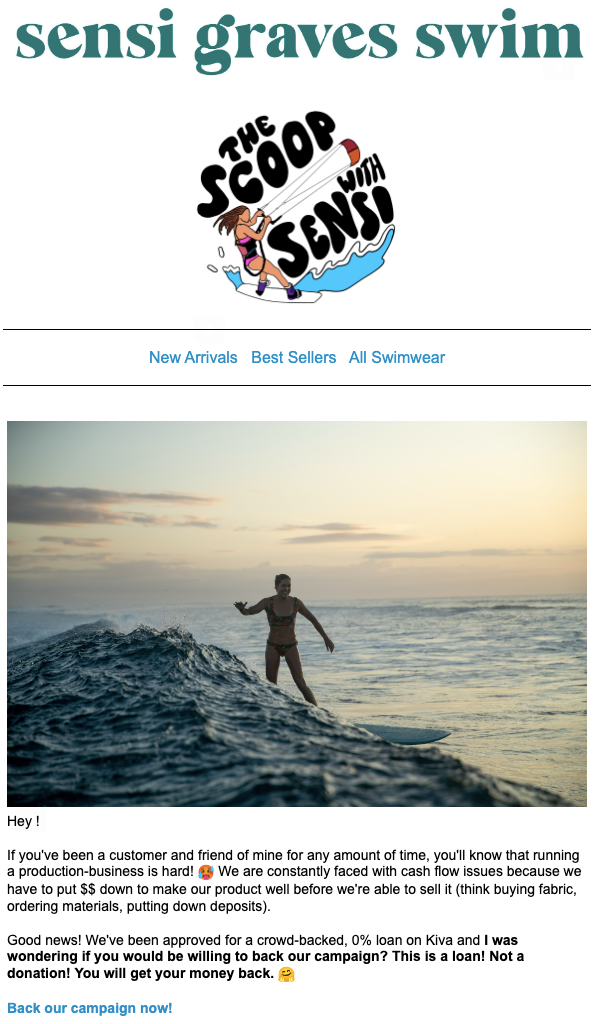 “When I'm saying, ‘Hey, we're looking at fundraising for our next production run,’ our customers are like, ‘Okay, yeah, I wanna support this,’” says founder Sensi Graves. “That helps it feel more like a community, rather than like we're just trying to sell something.”
“When I'm saying, ‘Hey, we're looking at fundraising for our next production run,’ our customers are like, ‘Okay, yeah, I wanna support this,’” says founder Sensi Graves. “That helps it feel more like a community, rather than like we're just trying to sell something.”
Ourside
Small-batch fragrance brand Ourside is proof that building an ecommerce community should never be an afterthought. Instead, it should be a core part of your messaging.
What does that look like in practice?
For an example, let’s dig into Ourside’s welcome series. Rather than pushing for an early sale, it shares their brand story through a simple, all-text email from founder Keta Burke-Williams…
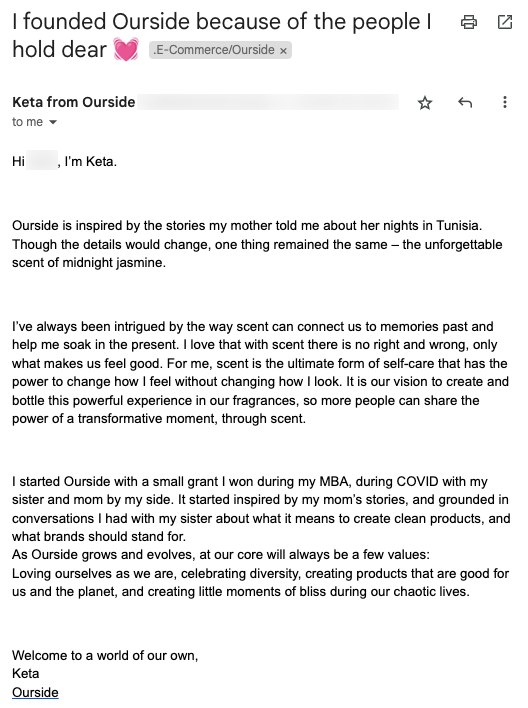 …followed up by a prompt to join the brand’s ecommerce community:
…followed up by a prompt to join the brand’s ecommerce community:
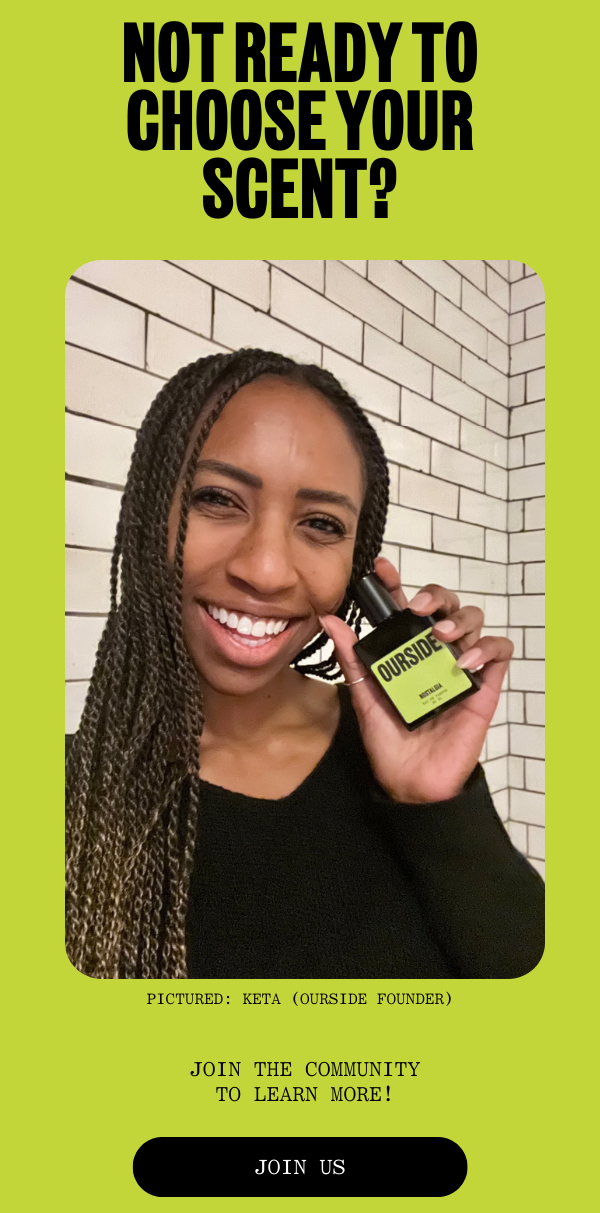 “It's really about building the brand story,” Keta says. “I'd rather have people who love us, and then they're encouraged to purchase, rather than being put off by us trying to upsell.”
“It's really about building the brand story,” Keta says. “I'd rather have people who love us, and then they're encouraged to purchase, rather than being put off by us trying to upsell.”
This approach is particularly important given Ourside’s niche, she explains.
“Fragrance is such an emotional purchase, so it's really important that we're able to tug at their heartstrings using our story.”

Build & Engage Your Ecommerce Community With Drip
Growing an active online community requires spot-on messaging from the moment you first connect with a new lead.
Drip can make that happen.
Our pre-built workflows help you craft high-converting email and onsite sequences to engage your audience, share your value proposition, and turn warm leads into active community members.
See what we can do for you and your online community by signing up for your free 14-day trial today!

